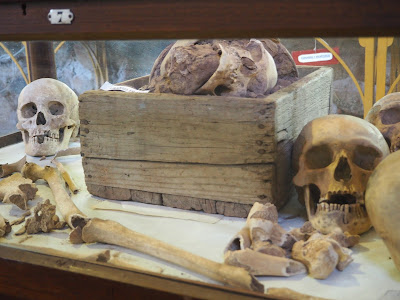 |
| Cable Car (Mining) Museum, Chilecito |
It is only a small town, but it has a warm and welcoming feel to it. It doesn't have the nice restaurants that La Rioja did, and in truth, there isn't much here, but it just felt like a good place to spend a few relaxing days. It also helped that there were plenty of little shops where we could buy decent meats, fruit and veg to make our healthy meals.
In general, we don't go to all that many museums on our travels, but as they were about the only thing open during the siesta period, we popped along to the Museum of Chilecito, which is in the old San Fransisco Mill.
 |
| San Fransisco Mill, Chilecito |
It's only a small place, and there isn't much information about the exhibits, but it had a few interesting elements.
The collection of artefacts from Chilecito's past, ranges from old burial pots and other wares belonging to the indigenous people of the region, to old typewriters presumably brought by the colonialists, and even a Commodore 64 computer.
We were a little surprised that there wasn't really anything on the mill itself, but it was decent enough to have a look around.
 |
| Church of the Sacred Heart of Jesus, Chilecito |
We also visited the Cable car museum. Chilecito was a mining town. The Sierra democratic Famatina was a rich source of minerals. The name Famatina means 'mother of metals', and it's bounty includes gold, silver, iron, copper and uranium.
It is likely that the indigenous people mined here, and the Argentines mined here in the 19th century. Indeed it was from this time that the town got its name; it began life as Santa Rita de Casia, but because so many of the miners originated from neighbouring Chile, it was nicknamed Little Chile, or Chilecito, and the name eventually became official.
 |
| Cable Car (Mining) Museum, Chilecito |
The mining rights were then given to the UK, in repayment of the money that it gave to Argentina, to help fund the wars that had been fought to bring about the unification of the different parts of the country.
The British wanted to improve the process, and so appointed a German company, Bleichart & Co, to build a cable car to transport the output down to the town.
 |
| Cable Car (Mining) Museum, Chilecito |
The mine was operated by the British until WWI, and then mining continued under other companies until 1926. There was an attempt to reopen it a while ago, but locals revisited due to the damage that it would cause to the town's irrigation systems.
 |
| Football Pitch at the Cable Car (Mining) Museum, Chilecito |
The museum at Station 1 is pretty basic. The proper guide wasn't there when we went, so it may be better if he is around, but as it was, the information was quite sparse. However it was quite interesting just to look around the station itself, with its carts still hanging from the rails.
It amused us that some of the carts have been redeployed (officially or otherwise) to mark out a football pitch next to the station.
 |
| Cable Car (Mining) Museum, Chilecito |
There is a further exhibition at Station 2, although we didn't go there. We had hoped to take a tour up to the last station, but unfortunately the rain has made the, already rough road, impassable.
We did take a couple of other tours out of town though, which I will cover in the next two posts.
 |
| Chilecito |
 |
| Chilecito |
 |
| Christo del Portezuelo, Chilecito |
 |
| Christo del Portezuelo, Chilecito |
 |
| Chilecito Museum, San Fransisco Mill, Chilecito |
 |
| Chilecito Museum, San Fransisco Mill, Chilecito |
 |
| Chilecito Museum, San Fransisco Mill, Chilecito |
 |
| Chilecito Museum, San Fransisco Mill, Chilecito |
 |
| Burial pot, Chilecito Museum, San Fransisco Mill, Chilecito |
 |
| Chilecito Museum, San Fransisco Mill, Chilecito |
 |
| Chilecito Museum, San Fransisco Mill, Chilecito |
 |
| Mining exhibits, Chilecito Museum, San Fransisco Mill, Chilecito |
 |
| Mining exhibits, Chilecito Museum, San Fransisco Mill, Chilecito |
 |
| Mining exhibits, Chilecito Museum, San Fransisco Mill, Chilecito |
 |
| Chilecito Museum, San Fransisco Mill, Chilecito |
 |
| Chilecito Museum, San Fransisco Mill, Chilecito |
 |
| Cable Car (Mining) Museum, Chilecito |
 |
| Cable Car (Mining) Museum, Chilecito |
 |
| Cable Car (Mining) Museum, Chilecito |
 |
| Cable Car (Mining) Museum, Chilecito |
 |
| Goats being taken for a walk, Chilecito |
No comments:
Post a Comment
We like to hear from you too, so please leave us a message here. We are also happy to answer any questions if we can help. Comments are moderated so will not appear straight away and there could be some delay in replying if we are travelling.